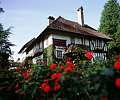
How the new flowers grow?
Every living thing has some means of reproducing itself. In flowers, the process takes place as follows:
A typical flower has four main parts. There is usually a green outer cup made up of leaflike sepals. Within the sepals are the petals. Within the petals are the reproductive organs necessary for producing seeds.
In the very centre of the flower are one or more pistils. Around the pistils ia a ring of stamens. The pistil is the female part of the flower. The bottom of it is enlarged and is called the ovary.
Inside the ovary are little round ovules, which later become seeds. But they become seeds only if they are fertilized by the contents of a pollen grain.

Pollen grains are produced by the stamens, the male organs of the flower. If seeds are to form, the pollen grains must go through the top of the pistil and reach the ovules at the bottom. The top of the pistil is called the stigma.
Pollen grains first fall on the stigma. They absorb moisture there from the sugary liquid on the surface. Then they swell and grow. The grain pushes down and becomes a tube.
The tube keeps growing down through the stalk of the pistil, then through the wall of the ovary, and then into an ovule.
The contents of the tube then empty into the ovule and fertilize it. Many pollen tubes may grow down to an ovary at the same time. Each tube will enter and fertilize a single ovule.
Only pollen from the same kind of plant will grow tubes and reach the ovules. The part of the stamen that produces pollen is called the anther.
The transfer of pollen from another to stigma is called pollination. If it takes place in the same flower, it is called self-pollination. If the pollen goes to a flower on a different plant of the same kind, it is called cross-pollination.
Cross-pollination of flowers is done by the wind, by insects, by birds, and by certain animals. Later on, the seeds that develop also have to be carried to a place where they can take root and grow into flowers.Sourse(my science book)










No comments:
Post a Comment